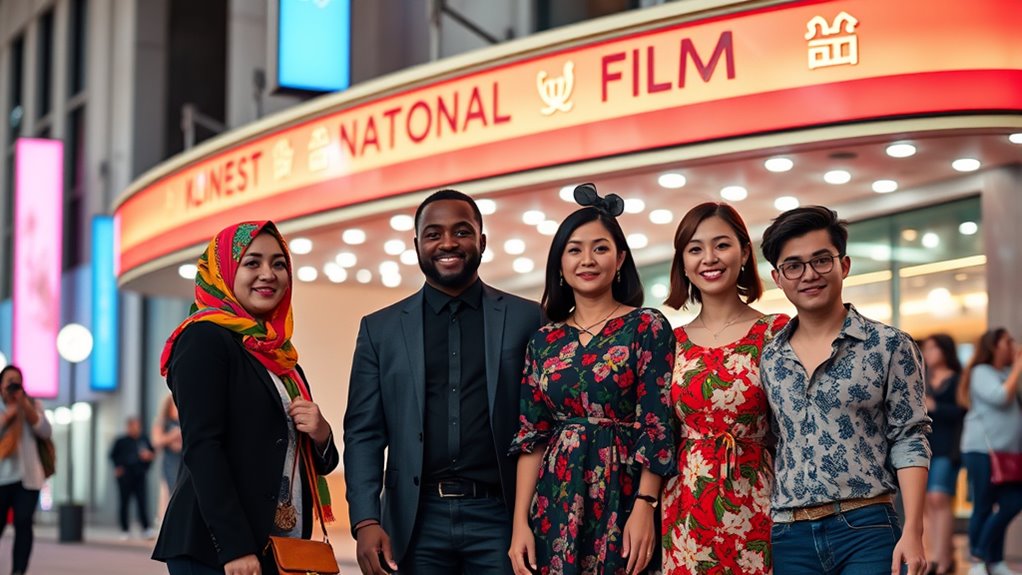Diversity quotas in international film festivals are increasingly being adopted to promote fair representation of underrepresented groups, including gender, ethnicity, and cultural backgrounds. While these policies help reshape narratives and create equitable opportunities, their implementation can face resistance and logistical challenges. Successful efforts depend on transparent processes and stakeholder collaboration. If you want to explore how these strategies are evolving and impacting the cinematic landscape, you’ll find plenty more insights ahead.
Key Takeaways
- Many international film festivals are adopting diversity quotas to improve representation of underrepresented groups.
- Implementation challenges include stakeholder resistance, logistical issues, and maintaining quality alongside diversity goals.
- Policies aim to create equitable opportunities for diverse storytellers and promote meaningful inclusion rather than tokenism.
- Transparency measures, such as reporting progress, help build trust and encourage stakeholder engagement in diversity initiatives.
- Success depends on ongoing collaboration, clear guidelines, and balancing cinematic excellence with diversity objectives.

International film festivals are increasingly adopting diversity quotas to promote representation across gender, ethnicity, and cultural backgrounds. This shift aims to address longstanding representation challenges that have historically marginalized certain groups. You might notice that festivals now set specific targets to guarantee that underrepresented voices get a chance to showcase their work. But implementing these policies isn’t always straightforward. You’ll see that policy implementation often faces hurdles, such as resistance from industry stakeholders or logistical complexities. Despite these obstacles, many festivals recognize that diversity enriches the cinematic landscape and attracts broader audiences.
Festivals now set diversity targets to showcase underrepresented voices amid implementation challenges.
When festivals introduce diversity quotas, they’re taking active steps to reshape the narrative around who gets to tell stories on the big stage. You’re likely to observe that these policies are designed to create a more equitable playing field, but their success depends heavily on how well they’re executed. For instance, some festivals establish clear guidelines for selecting films that meet their diversity criteria, while others face challenges in balancing quality with representation goals. You might also notice that policy implementation involves ongoing adjustments—what works in one festival might not be as effective in another. This process requires continuous feedback and a willingness to refine approaches to truly promote inclusion.
There’s also a strategic aspect to how festivals approach these policies. They often collaborate with industry partners, advocacy groups, and cultural organizations to set realistic, impactful quotas. By doing so, they aim to foster a more inclusive environment that isn’t just a token gesture but a meaningful shift in how films are selected and celebrated. You’ll see that some festivals adopt transparent reporting measures to track their progress, which helps build trust and accountability. This transparency can motivate filmmakers from diverse backgrounds to participate, knowing their work has a fair chance of being recognized.
Ultimately, the success of diversity quotas hinges on effective policy implementation. It’s about more than just setting numbers; it’s about creating a genuine commitment to diversity that influences every stage of the festival process—from submission and selection to screening and awards. As you follow these developments, you’ll notice that ongoing dialogue, stakeholder engagement, and a clear vision are crucial. These efforts demonstrate that international film festivals are taking real steps toward overcoming representation challenges, making the cinematic world more inclusive and reflective of the diverse stories it has to tell. Additionally, incorporating high-quality standards alongside diversity goals can help ensure that the overall cinematic experience remains compelling and engaging for audiences.
Frequently Asked Questions
How Do Diversity Quotas Impact Filmmaker Creativity?
You might worry that diversity quotas could limit filmmaker innovation, but they often inspire you to think creatively about representation metrics. By emphasizing diverse stories, you’re encouraged to explore new perspectives and challenge traditional narratives. This environment pushes you to develop fresh, authentic content that resonates globally. Instead of restricting creativity, diversity quotas can serve as catalysts, prompting you to innovate and craft more inclusive, compelling films that reflect a wider range of human experiences.
Are There Penalties for Not Meeting Diversity Quotas?
Imagine a team missing its target shot—that’s what happens if you don’t meet diversity quotas. While penalties for not meeting quota compliance vary, some festivals might exclude films or disqualify submissions if they don’t meet diversity metrics. Others could offer warnings or require adjustments. Ultimately, missing these quotas risks reducing your chances of acceptance, emphasizing the importance of aligning your submission with diversity goals.
How Are Diversity Quotas Monitored and Enforced?
You might wonder how diversity quotas are monitored and enforced, especially considering audience perceptions and industry reactions. Typically, organizers track submission data and review committee reports to make sure compliance. They may also conduct audits or require accountability reports. If quotas aren’t met, festivals can face reputational risks, leading to industry critique or shifting audience perceptions. Enforcement often relies on transparency and consistent follow-up to uphold diversity goals effectively.
Do Quotas Influence the Overall Selection Quality?
Imagine a film festival implementing diversity quotas; you might worry it could lower selection quality. However, studies show that quotas often enhance audience perception by showcasing diverse voices, enriching the festival experience. Industry reputation can grow, too, as festivals become more inclusive and representative. While some fear quotas might limit quality, they can actually elevate the overall selection, attracting broader audiences and fostering innovation within the industry.
What Are the Criteria for Defining Underrepresented Groups?
You should consider criteria like cultural representation, where underrepresented groups are those who lack visibility in mainstream media. Audience perception plays a role, as marginalized communities often face misrepresentation or tokenism. Defining these groups involves examining social, racial, or ethnic identities, ensuring diverse voices are acknowledged. Recognizing these criteria helps promote inclusivity, fostering authentic cultural representation that resonates with audiences and broadens the scope of storytelling in film festivals.
Conclusion
Just like a well-balanced film cast brings a story to life, diversity quotas guarantee every voice is heard on the global stage. Remember the story of a small festival that implemented quotas and suddenly saw a richer tapestry of stories, audiences, and perspectives. It’s like adding vibrant colors to a black-and-white film—you realize the true beauty only when every shade is included. Embracing diversity isn’t just fair; it’s what makes our cinematic world truly unforgettable.









